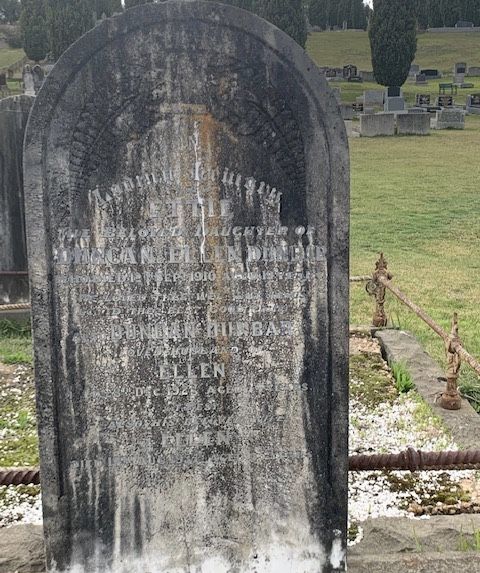Hazelwood Cemetery - More Unmarked Graves
By Leo Billington
In the June edition of Churchill and District News, it was pointed out that approximately 25% of interments in our cemetery, now over 140 years old, are recorded as “unmarked”. It’s understood this figure is a close average for Victorian country cemeteries.
Using digitalised data, now recorded in Microsoft Access file format, matched with histories gleaned from past copies of the Morwell Advertiser, the Melbourne Argus and the Age, a range of stories has been uncovered.

For instance, Mr William Lacey, a resident of Gunyah, lies in an unmarked grave. His death in November 1926 resulted from a fractured skull sustained by falling from a horse while returning home from Boolarra. At 62 years of age, Mr Lacey had been living and working as a farm labourer on a dairy farm at Gunyah. Evidence given at a magisterial inquiry included “there was a full bottle of whisky in the deceased’s coat pocket.”
Another unmarked grave records the death of a young 20-year-old lady who passed away at her mother’s Morwell home in October 1897. After a long illness associated with rheumatic fever and heart disease, both of which confined her to bed at home for almost 18 months, the deceased had previously spent time in Sydney to restore her health and strength.
Mr William Sharp, for many years the only chemist in Morwell, was interred in the Hazelwood Cemetery in October 1897. His obituary was published in the Morwell Advertiser:
Mr W. Sharp, of this town, passed from this mundane sphere to the unknown, having reached the ripe old age of 77 years. Deceased had been suffering for years from heart disease, and during the last month or two was confined to his bed. He was a very old resident of the district, and for many years was the only chemist in Morwell. It appears that he has no relations in the colony and none are known of elsewhere. Deceased was supposed to be in very comfortable circumstance, but his will has not yet been made public property. Among the numerous instructions left for the executors to carry out was an order that he (deceased) should be buried at 7 a.m.; he wished no one to attend the funeral, and desired no fuss whatever to be made about his death, which was not to be advertised. We understand that the instructions are being followed as close as possible.
Motor cyclist, eighteen-year-old John Kelly, of Morwell died as a result of injuries from colliding with a truck in Morwell in March 1953. His is an unmarked grave; as is the grave for Florrie Butters, better known as “Ivy” Butters.
As reported in the Morwell Advertiser October 22, 1897, a bright little girl of nine summers, in company with a number of other children, went fishing at a deep water hole, or rather an old clay hole in Corbet's brick yards, which is about 200 yards from the main road and fenced round with post and rails. A popular student at the local state school, Ivy accidentally drowned by slipping into the 10 feet deep water hole.
There are situations where young children were interred in graves of adults. Presumably, there was a family connection although these cases are recorded as “unmarked”, while details of the adults are recorded on headstones. The accompanying photograph shows one of these graves.
Amongst unmarked graves in the Old Catholic section at Hazelwood is one for a 56-year-old male who died at the then Morwell Police Station in December 1951. Of “no fixed abode”, he was first located at the recreation reserve, but according to two Police constables, “his condition was such he was unable to give his name and address.”
Another deceased male was discovered in bed in a cubicle at Ridge Hostel, Morwell, in June 1951. As reported in the Morwell Advertiser June 21, 1951, the deceased had been dead for some days. “War medals found in the cubicle disclosed that he was an A.I.F. veteran of World War 1 and, under the circumstances the responsibility for his burial was undertaken by the Morwell Sub-branch of the R.S.L.” Interred at Hazelwood, in an unmarked grave, this location ought to be recognised by an appropriate plaque.
A young boy, seven months old Donald, lies in his unmarked grave. Interred in September 1951, he died from malnutrition alongside acute bronchitis, early meningitis and myocarditis.
On New Year’s Eve, January 1900, Walter Doolan was found lying dead a short distance from Penaluna’s hotel in Boolarra. Subsequent police enquiries lead to two brothers being arrested five days later and charged with murder. Newspapers throughout most of country Victoria carried versions of Walter’s death coupled with allegations about the brothers.
While it seems a drunken fight had broken out amongst New Year’s Eve revellers, and there being many accusations about finite details, the brothers were eventually acquitted.
Walter now rests in peace in the Old Catholic section in an unmarked grave.
Hazelwood Cemetery holds many and varied stories, some easy to track, others not so.


